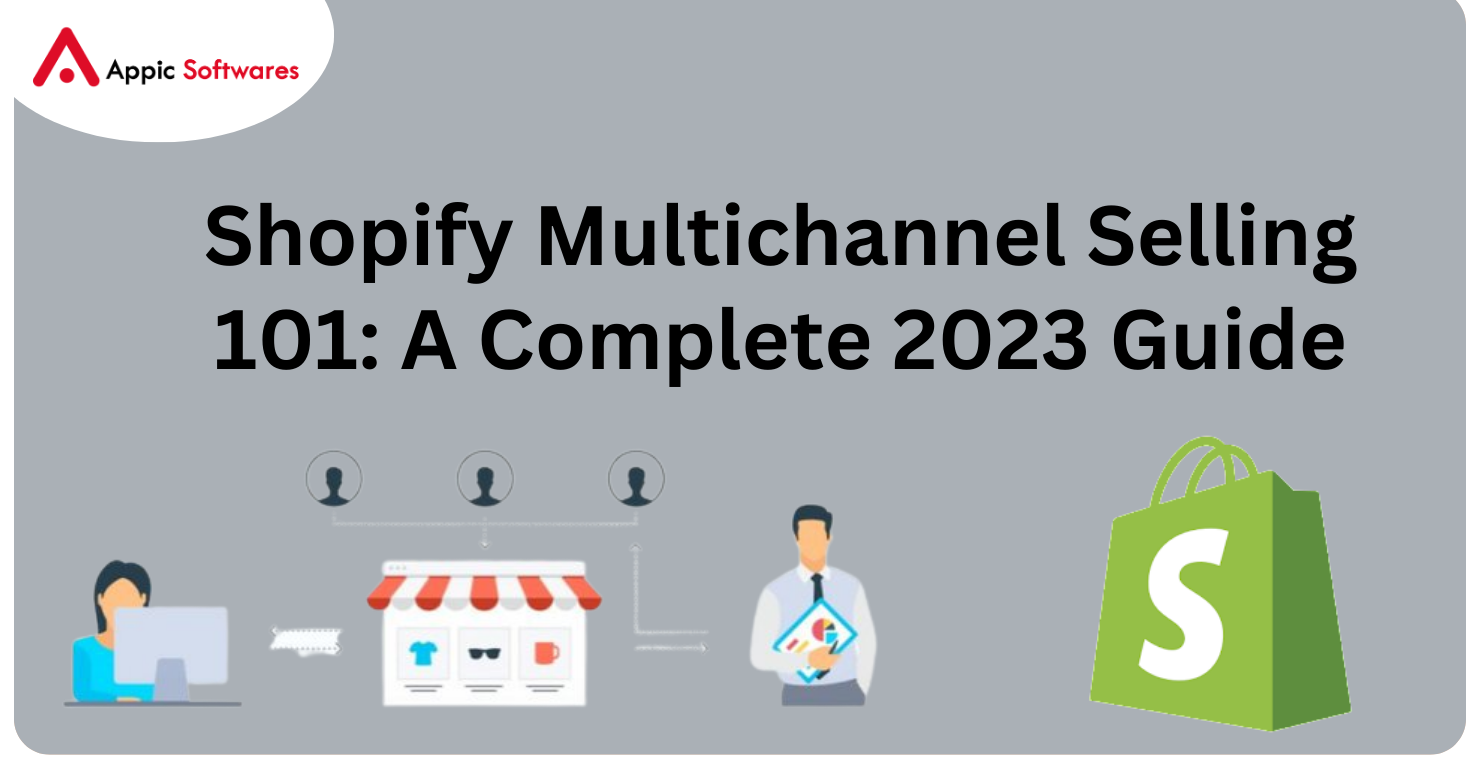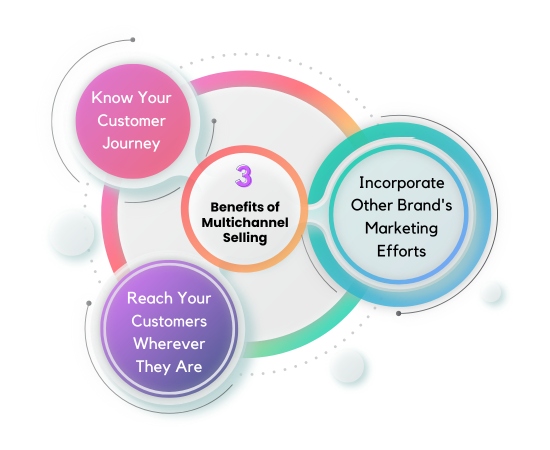
Do you know Shopify’s annual revenue is 5.6bn USD? The time when consumers could only purchase goods from brick-and-mortar businesses is long behind us. Customers can shop through a variety of channels nowadays, including conventional stores, online stores, and social commerce apps.
In order to reach clients wherever they are, it is important to have a presence on a variety of sales channels when operating a firm. By doing this, you open the door to multichannel selling. Multichannel selling is the process of marketing products and services across various channels of distribution.
We’ll go over what sales channels are in this article as well as what multichannel selling with Shopify entails. Additionally, we shall look at the advantages that sellers might gain from Finally, we’ll talk about the biggest problems and recommended methods.
What Is Shopify?
On the online shopping platform known as Shopify, anyone may set up an online store and sell their products. With Shopify POS, retailers can also conduct in-person sales of their goods.
Today’s top e-commerce platform for companies of all sizes is Shopify. Whether you sell online, via social media, offline, in person, or out of the trunk of your car, Shopify has you covered.
Since we launched the first Shopify store, it has been our goal to improve commerce overall.
How Do Sales Channels Work?
A company uses a sales channel as a strategy to directly or indirectly market goods and services to its target market. Adding sales channels to Shopify can make it easier to manage goods or services, orders, and clients all in one place.
According to Gartner, a sales channel is the method a business-to-business (B2B) sales organization uses to reach end clients directly or through intermediaries to sell their products or solutions.
Note: Later on in this post, we’ll talk about how to add, remove, and see sales channels in Shopify.
What Is Multichannel Selling, And Which Channels Does It Encompass?
Multichannel selling is the process by which a company examines numerous sales channels to offer products and services to its clients. In addition to having a physical presence in the form of brick-and-mortar businesses, a multichannel selling process can also incorporate internet channels like Amazon, eBay, etc.
Let’s explore both areas in greater detail.
-
Physical Environments
Physical stores, which have been around for a while, have consistently been one of the most popular retail options for modern consumers.
-
Individual Retail Locations
Some companies own and manage their physical locations, where they sell products and services to clients. Manufacturers and makers are also retailers, excluding this.
-
Shops That Sell Multiple Bands
When you sell your goods to a store like that, you either sell straight to the store or possibly through a third-party distributor who acts as a middleman and sells the goods to the store first.
-
Actual Stores And Bazaars
This category includes events like street festivals, craft fairs, and farmer’s markets where sellers set up shop and deal with customers directly.
-
Online Locations
The majority of retail establishments operate online; some encourage face-to-face connections while clients pick up the goods, while others deliver right to the customer’s door. Online shoppers make purchases regardless of the situation.
-
Internet
Customers can make direct purchases using the most basic online sales platform, which is a website with an eCommerce platform.
-
Internet Markets
Leaders in online warehousing include Amazon in this area. Amazon lists, stores (in warehouses), ships, and collects a profit on products from third parties. It also includes e-commerce sites that connect customers and sellers directly, such as eBay and Etsy.
The fulfillment of orders, which includes handling and shipping, falls under the purview of sellers who use such platforms for online selling. They must uphold the standards established by these platforms. They forfeit their account if they don’t do that.
-
Mobile-Native Marketplaces
Mobile e-commerce platforms have recently seen an increase in e-commerce sales. Businesses, like Wish and Joom, are choosing to offer their products on these powerful mobile apps. Although these apps may only provide sellers with tiny profit margins, the nicest thing about them is the client information they supply. This makes it simpler for the merchants to link their clients to their products so they may make purchases.
- Comparative Websites
Google and other comparison websites contribute to giving clients a better online buying experience. Unlike links to merchant websites, Google does not provide a direct purchasing option. Customers can explore product listings for comparable items sold by various sellers on these referral websites. To make a purchase, customers can click on them to go to the seller’s website. In addition, buyers can use price comparison websites to find products at the lowest cost and save money.
-
Social Media Marketplaces
Brands utilize social media platforms like Instagram and Facebook to market their products and services to their followers or draw in new audiences through sponsored posts. These platforms are also known as social commerce websites or apps. Users can do this without even leaving their page, immediately purchasing products from their feeds.
| Available Online Sales Channels on Shopify | |
| Online Store | Choose a Shopify-hosted platform for selling your products at myshopify.com, or you can set up your own domain as well. |
| You may promote and sell your products straight on the Facebook page for your shop by selecting the Shop option. | |
| Sellers can post their products on Instagram and make sales from them. | |
| Wholesale Channel | In a password-protected storefront, retailers can offer their goods wholesale to other companies. They can use the Shopify Plus package to access their wholesale channel. |
| Buy Button | Businesses can sell their products from their blog or website (WordPress or Squarespace) by adding buy buttons connected with their Shopify checkout. |
| Shopify Inbox | Maintain constant contact with your consumers and centralize customer chats that are linked to various messaging services. |
| Shop | On the Shop app, the Shop channel aids in managing brand presence and boosting customer engagement. |
| Handshake | Retailers can browse wholesale products listed by businesses on the Handshake wholesale marketplace. |
What Advantages Does Shopify’s Multichannel Selling Offer?

1. Understand the Customer Journey
Naturally, you can never predict where or on what platform or marketplace a customer will complete their transaction. They merely look for the least expensive, highest-quality stuff. They begin by clicking on a social media post or advertisement for it before purchasing a marketplace.
You are aware of your potential customer’s journey because you are present on several Shopify channels.
2. Speak to Your Clients Anywhere They May Be
Customers’ tastes vary depending on user demographics and geographic areas. As a seller, it is your responsibility to make sure that your customers can access your store.
Your mobile-friendly shop will be accessible to every consumer based on their phones if you choose Shopify’s multichannel selling option.
3. Include Marketing Initiatives From Other Brands
Online marketplaces demand commissions from vendors that use their platforms to sell their goods. You are indirectly utilizing their reputation as a trading brand.
You can take advantage of every channel on which you are selling your products by thinking about multichannel selling with Shopify. Yes, this will result in increased sales and growth.
How Can I View, Add, Or Remove Sales Channels?
1. Adding an Online Sales Channel: Steps
The procedures for adding an online sales channel to your Shopify admin are listed below.
For Desktop-
- Click Settings > Apps and Sales Channels from your Shopify admin.
- Click Visit the Shopify App Store on the page for applications and sales channels.
- Find the sales channel you wish to add by searching.
- To add a channel, click.
For iPhone-
- Click Store from the Shopify app.
- Tap Add Channel in the Sales Channel section.
- Click the sales channel you want to add on the Add Sales Channel screen.
- Click Add channel.
For Android-
- Tap the add button in the Sales Channel column.
- Click the sales channel you want to add on the Add Sales Channel screen.
- Click Add channel.
2. Removal Procedures for Online Sales Channels
The methods to delete an online sales channel from your Shopify admin are listed below.
For Desktop-
- In your Shopify admin, choose Settings > Apps and Sales Channels.
- Near the name of the sales channel you want to eliminate, click Remove.
- If you would like, enter a reason for removing the channel.
- select “confirm”
For iPhone-
- Click Store > Settings from the Shopify app.
- Go to the sales channels.
- Near the sales channel you wish to delete, click the trash icon.
- Hit “confirm.”
Click Store > Settings in the Shopify app for Android.
- Go to the sales channels.
- Near the sales channel you wish to delete, click the trash icon.
- Hit “confirm.”
3. Access Dashboards for Sales Channels
Every sales channel has a dashboard where you can view a thorough summary of the recent traffic and sales for your channel. Additionally, on Shopify Home, you can assess its effectiveness by choosing a sales channel from the menu.
What Obstacles Does Shopify’s Multichannel Selling Face?

-
Management of Customer Experience
When you decide to sell through several channels, whether they be physical storefronts or online marketplaces, a third party handles the customer service. Such services with a negative impact could harm your brand’s reputation if not delivered properly.
On the other hand, you will need more time and effort if you decide to manage every channel by yourself in order to respond to consumer questions or moderate every social media comment.
-
Inventory Control
When you become overburdened with rising order values from numerous markets, inventory management might be difficult. If you receive online payment for a product that is soon to expire, your only choice would be to cancel the order. And this can affect the reputation of your brand.
-
Account Administration
Choosing multichannel selling necessitates maintaining business relationships with numerous distinct businesses. It entails dealing with paperwork, compliance requirements, tax reporting, listing protocols, etc., all of which can take time.
Which Best Practices for Multichannel Selling Should You Adopt?
It’s time to study the finest practices you should adhere to in order to achieve the intended results now that you are aware of the difficulties that one may have after adopting multichannel selling.
1. Begin by considering a small scope and afterward expand it
Your customer support and order fulfillment will suffer if you decide to have a presence on various marketplaces, as we’ve already explained. Start with less and increase your efforts as you see fit after evaluating the results. Later, after honing your order fulfillment skills on your website, you can decide to sell to well-known companies that adhere to rigid criteria when it comes to order fulfillment.
2. Continue to Build Your Brand’s Presence
Make sure your brand is present consistently across all of the marketplaces. Regardless of the purchasing method, it demands the same degree of quality, price, and customer service.
Conclusion
We hope that you were able to gain knowledge about Shopify Multichannel Selling.
If you’re looking for an e-commerce app development company, nevertheless, you should look into Appic Softwares.
We have a skilled team of engineers who are proficient in the most recent technologies, including AI, Flutter, React, and others.
So, what are you waiting for?








